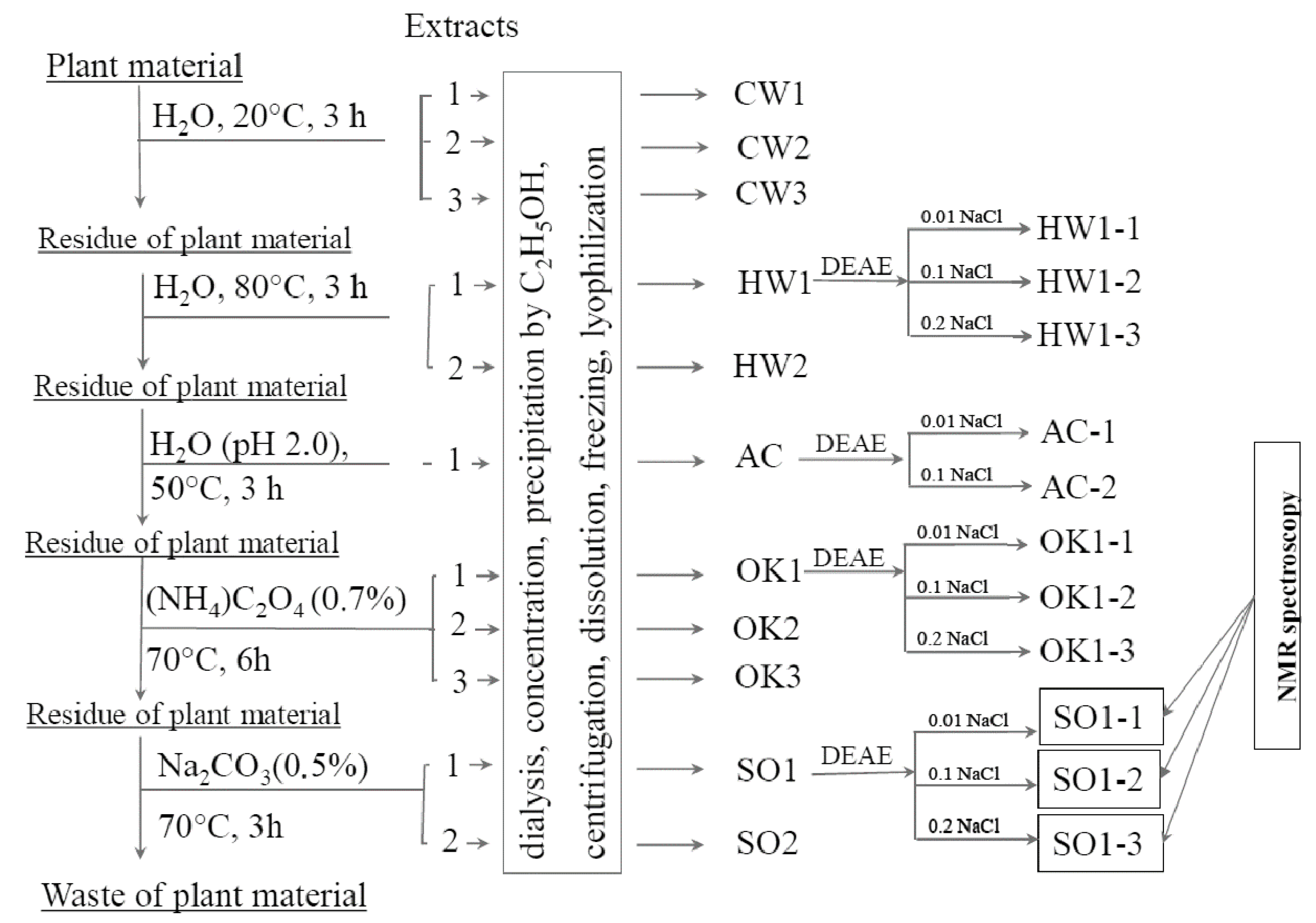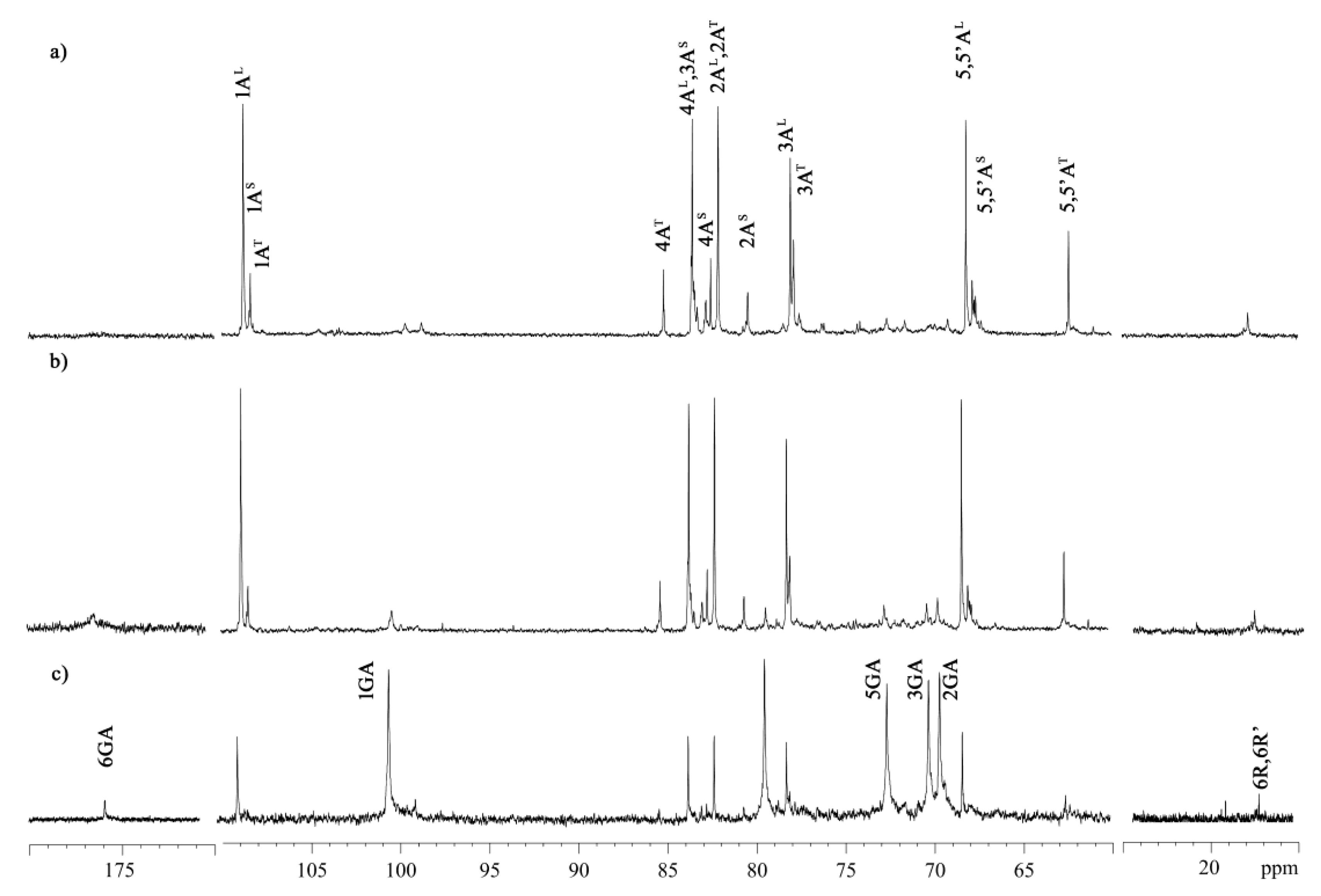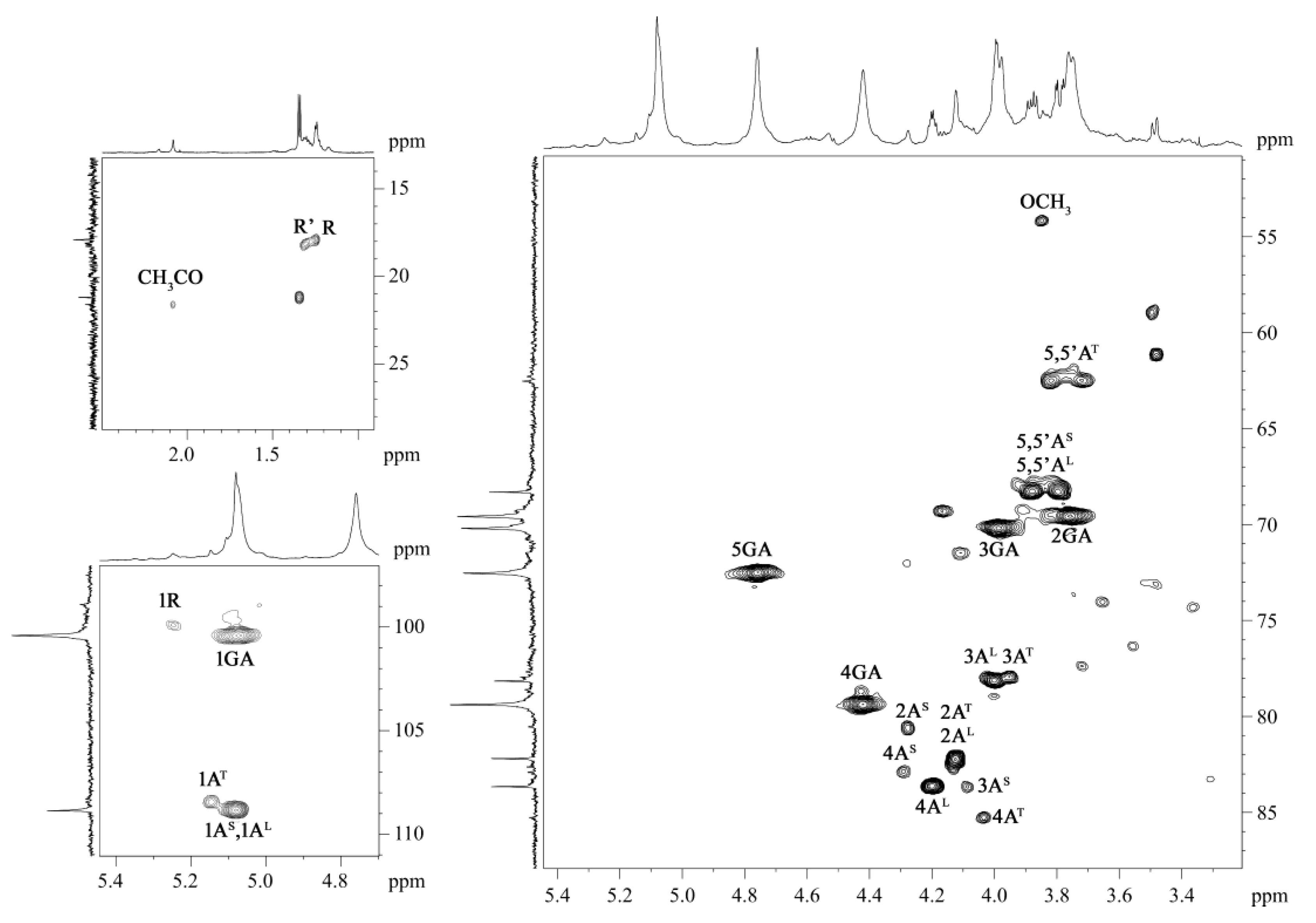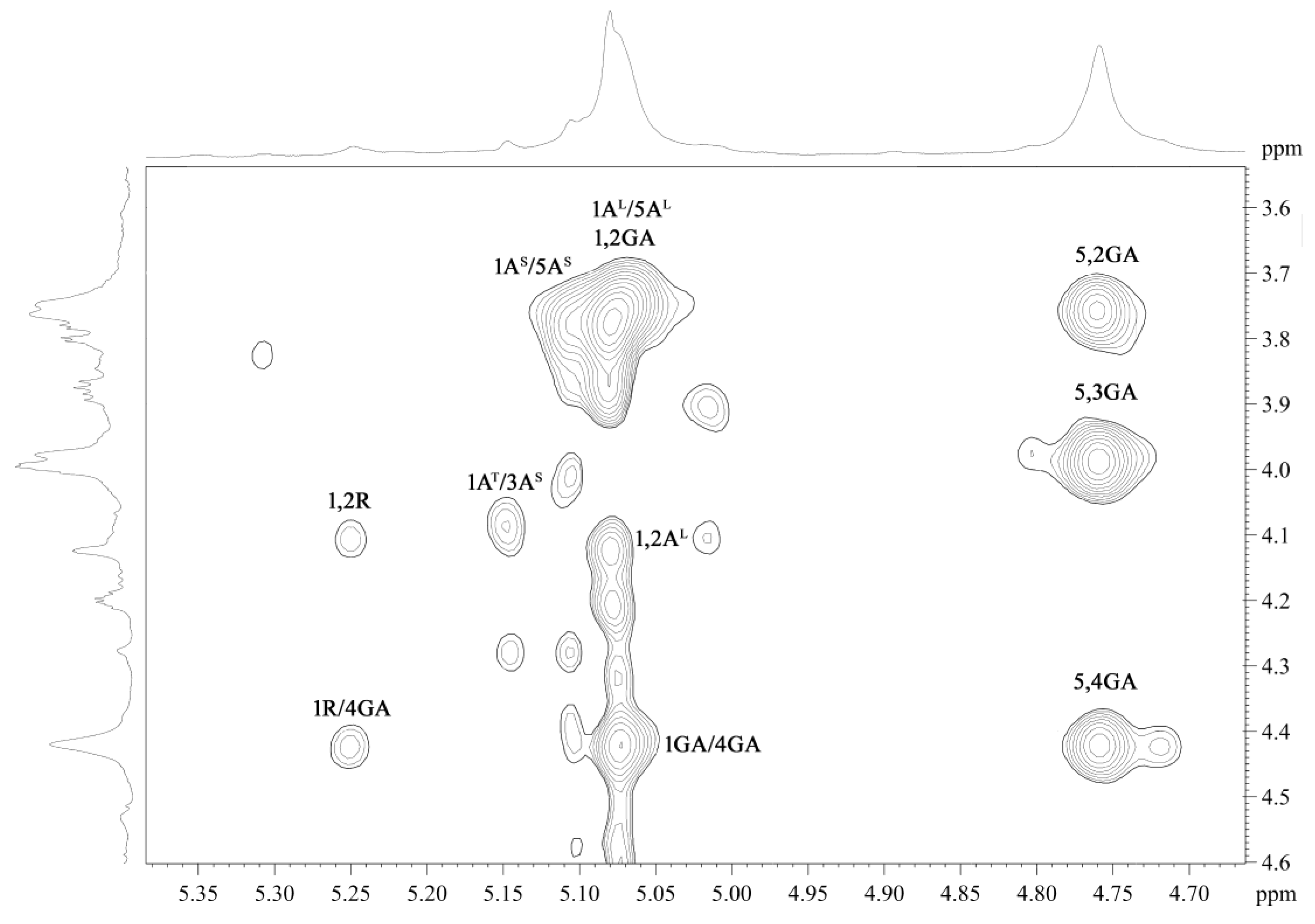Polysaccharides of Salsola passerina: Extraction, Structural Characterization and Antioxidant Activity
Abstract
:1. Introduction
2. Results and Discussion
2.1. Isolation and Characterization of Polysaccharides
2.2. NMR Spectroscopic Study
2.3. DPPH Radical-Scavenging Activity
3. Materials and Methods
3.1. Materials
3.2. Isolation of Polysaccharides of S. passerina
3.3. Ion Exchange Chromatography of Polysaccharide Fractions
3.4. General Analytical Methods
3.5. Nuclear Magnetic Resonance Spectroscopy
3.6. Antioxidant Activity
3.7. Statistical Analysis
4. Conclusions
Supplementary Materials
Author Contributions
Funding
Institutional Review Board Statement
Informed Consent Statement
Data Availability Statement
Acknowledgments
Conflicts of Interest
Appendix A
References
- Mosyakin, S.L. A taxonomic synopsis of the genus Salsola (Chenopodiaceae) in North America. Ann. Mo. Bot. Gard. 1996, 83, 387–395. [Google Scholar] [CrossRef]
- Akhani, H.; Trimborn, P.; Ziegler, H. Photosynthetic Pathways In Chenopodiaceae from Africa, Asia and Europe with Their Ecological, Phytogeographical and Taxonomical Importance. Plant Syst. Evol. 1997, 206, 187–221. [Google Scholar] [CrossRef]
- Murshid, S.S.A.; Atoum, D.; Abou-Hussein, D.R.; Abdallah, H.M.; Hareeri, R.H.; Almukadi, H.; Edrada-Ebel, R. Genus Salsola: Chemistry, Biological Activities and Future Prospective—A Review. Plants 2022, 11, 714. [Google Scholar] [CrossRef] [PubMed]
- Tundis, R.; Menichini, F.; Conforti, F.; Loizzo, M.R.; Bonesi, M.; Statti, G.; Menichini, F. A Potential Role of Alkaloid Extracts from Salsola Species (Chenopodiaceae) in the Treatment of Alzheimer’s Disease. J. Enzym. Inhib. Med. Chem. 2009, 24, 818–824. [Google Scholar] [CrossRef] [PubMed] [Green Version]
- Tundis, R.; Loizzo, M.R.; Statti, G.A.; Menichini, F. Inhibitory Effects on the Digestive Enzyme Alpha-Amylase of Three Salsola Species (Chenopodiaceae) in Vitro. Pharmazie 2007, 62, 473–475. [Google Scholar]
- Hamed, A.I.; Masullo, M.; Sheded, M.G.; Mahalel, U.A.; Tawfik, M.M.; Perrone, A.; Piacente, S. Triterpene Saponins from Salsola Imbricata. Phytochem. Lett. 2011, 4, 353–356. [Google Scholar] [CrossRef]
- Beyaoui, A.; Chaari, A.; Ghouila, H.; Ali Hamza, M.; Ben Jannet, H. New Antioxidant Bibenzyl Derivative and Isoflavonoid from the Tunisian Salsola tetrandra Folsk. Nat. Prod. Res. 2012, 26, 235–242. [Google Scholar] [CrossRef]
- Ridley, B.L.; O’Neill, M.A.; Mohnen, D. Pectins: Structure, biosynthesis, and oligogalacturonide-related signaling. Phytochemistry 2001, 57, 929–967. [Google Scholar] [CrossRef]
- Voragen, A.G.J.; Coenen, G.-J.; Verhoef, R.P.; Schols, H.A. Pectin, a versatile polysaccharide present in plant cell walls. Struct. Chem. 2009, 20, 263–275. [Google Scholar] [CrossRef] [Green Version]
- Naqash, F.; Masoodi, F.A.; Rather, S.A.; Wani, S.M.; Gani, A. Emerging concepts in the nutraceutical and functional properties of pectin—A review. Carbohydr. Polym. 2017, 168, 227–239. [Google Scholar] [CrossRef]
- Minzanova, S.T.; Mironov, V.F.; Arkhipova, D.M.; Khabibullina, A.V.; Mironova, L.G.; Zakirova, Y.M.; Milyukov, V.A. Biological activity and pharmacological application of pectic polysaccharides: A review. Polymers 2018, 10, 1407. [Google Scholar] [CrossRef] [PubMed]
- Tan, M.; Chang, S.; Liu, J.; Li, H.; Xu, P.; Wang, P.; Wang, X.; Zhao, M.; Zhao, B.; Wang, L.; et al. Physicochemical Properties, Antioxidant and Antidiabetic Activities of Polysaccharides from Quinoa (Chenopodium quinoa Willd.) Seeds. Molecules 2020, 25, 3840. [Google Scholar] [CrossRef]
- Wu, D.-T.; Liu, W.; Han, Q.-H.; Wang, P.; Xiang, X.-R.; Ding, Y.; Zhao, L.; Zhang, Q.; Li, S.-Q.; Qin, W. Extraction Optimization, Structural Characterization, and Antioxidant Activities of Polysaccharides from Cassia Seed (Cassia obtusifolia). Molecules 2019, 24, 2817. [Google Scholar] [CrossRef] [PubMed] [Green Version]
- Klosterhoff, R.R.; Bark, J.M.; Glänzel, N.M.; Iacomini, M.; Martinez, G.R.; Winnischofer, S.M.B.; Cordeiro, L.M.C. Structure and intracellular antioxidant activity of pectic polysaccharide from acerola (Malpighia emarginata). Int. J. Biol. Macromol. 2018, 106, 473–480. [Google Scholar] [CrossRef] [PubMed]
- Patova, O.; Smirnov, V.; Golovchenko, V.; Vityazev, F.; Shashkov, A.; Popov, S. Structural, rheological and antioxidant properties of pectins from Equisetum arvense L. and Equisetum sylvaticum L. Carbohydr. Polym. 2019, 209, 239–249. [Google Scholar] [CrossRef]
- Zeng, F.; Chen, W.; He, P.; Zhan, Q.; Wang, Q.; Wu, H.; Zhang, M. Structural characterization of polysaccharides with potential antioxidant and immunomodulatory activities from Chinese water chestnut peels. Carbohydr. Polym. 2020, 246, 116551. [Google Scholar] [CrossRef]
- Ma, X.; Yu, J.; Jing, J.; Zhao, Q.; Ren, L.; Hu, Z. Optimization of Sunflower Head Pectin Extraction by Ammonium Oxalate and the Effect of Drying Conditions on Properties. Sci. Rep. 2021, 11, 10616. [Google Scholar] [CrossRef]
- Ning, X.; Liu, Y.; Jia, M.; Wang, Q.; Sun, Z.; Ji, L.; Mayo, K.H.; Zhou, Y.; Sun, L. Pectic Polysaccharides from Radix Sophorae tonkinensis Exhibit Significant Antioxidant Effects. Carbohydr. Polym. 2021, 262, 117925. [Google Scholar] [CrossRef]
- Zhang, T.; Shuai, M.; Ma, P.; Huang, J.; Sun, C.; Yao, X.; Chen, Z.; Min, X.; Yan, S. Purification, chemical analysis and antioxidative activity of polysaccharides from pH-modified citrus pectin after dialyzation. LWT 2020, 128, 109513. [Google Scholar] [CrossRef]
- Wang, W.; Ma, X.; Jiang, P.; Hu, L.; Zhi, Z.; Chen, J.; Ding, T.; Ye, X.; Liu, D. Characterization of pectin from grapefruit peel: A comparison of ultrasound-assisted and conventional heating extractions. Food Hydrocoll. 2016, 61, 730–739. [Google Scholar] [CrossRef]
- Wang, J.; Hu, S.; Nie, S.; Yu, Q.; Xie, M. Reviews on Mechanisms of In Vitro Antioxidant Activity of Polysaccharides. Oxid. Med. Cell Longev. 2016, 2016, 5692852. [Google Scholar] [CrossRef] [PubMed]
- Bock, K.; Pedersen, C. Carbon-13 Nuclear Magnetic Resonance Spectroscopy of Monosaccharides. In Advances in Carbohydrate Chemistry and Biochemistry; Academic Press: Cambridge, MA, USA, 1983; pp. 27–66. [Google Scholar] [CrossRef]
- Shashkov, A.S.; Lipkind, G.M.; Knirel, Y.A.; Kochetkov, N.K. Stereochemical Factors Determining the Effects of Glycosylation on The13C Chemical Shifts in Carbohydrates. Magn. Reson. Chem. 1988, 26, 735–747. [Google Scholar] [CrossRef]
- Lipkind, G.M.; Shashkov, A.S.; Knirel, Y.A.; Vinogradov, E.V.; Kochetkov, N.K. A Computer-Assisted Structural Analysis of Regular Polysaccharides on the Basis of 13C-n.m.r. Data. Carbohydr. Res. 1988, 175, 59–75. [Google Scholar] [CrossRef]
- Golovchenko, V.V.; Khramova, D.S.; Shashkov, A.S.; Otgonbayar, D.; Chimidsogzol, A.; Ovodov, Y.S. Structural Characterisation of the Polysaccharides from Endemic Mongolian Desert Plants and Their Effect on the Intestinal Absorption of Ovalbumin. Carbohydr. Res. 2012, 356, 265–272. [Google Scholar] [CrossRef] [PubMed]
- Altona, C.; Haasnoot, C.A.G. Prediction Of Anti And Gauche Vicinal Proton-Proton Coupling Constants in Carbohydrates: A Simple Additivity Rule for Pyranose Rings. Org. Magn. Reson. 1980, 13, 417–429. [Google Scholar] [CrossRef]
- Jansson, P.-E.; Kenne, L.; Widmalm, G. Computer-Assisted Structural Analysis of Polysaccharides with an Extended Version of Casper Using 1H- and 13C-n.m.r. Data. Carbohydr. Res. 1989, 188, 169–191. [Google Scholar] [CrossRef]
- Cyr, N.; Perlin, A.S. The Conformations of Furanosides. A 13C Nuclear Magnetic Resonance Study. Can. J. Chem. 1979, 57, 2504–2511. [Google Scholar] [CrossRef] [Green Version]
- Angyal, S.J. Hudson’s Rules of Isorotation as Applied to Furanosides, and the Conformations of Methyl Aldofuranosides. Carbohydr. Res. 1979, 77, 37–50. [Google Scholar] [CrossRef]
- Sengkhamparn, N.; Bakx, E.J.; Verhoef, R.; Schols, H.A.; Sajjaanantakul, T.; Voragen, A.G.J. Okra Pectin Contains an Unusual Substitution of Its Rhamnosyl Residues with Acetyl and Alpha-Linked Galactosyl Groups. Carbohydr. Res. 2009, 344, 1842–1851. [Google Scholar] [CrossRef]
- Albersheim, P.; Darvill, A.G.; O’Neill, M.A.; Schols, H.A.; Voragen, A.G.J. An Hypothesis: The Same Six Polysaccharides Are Components of the Primary Cell Walls of All Higher Plants. In Progress in Biotechnology; Elsevier: Amsterdam, The Netherlands, 1996; pp. 47–55. [Google Scholar] [CrossRef]
- Ding, H.H.; Cui, S.W.; Goff, H.D.; Chen, J.; Wang, Q.; Han, N.F. Arabinan-Rich Rhamnogalacturonan-I from Flaxseed Kernel Cell Wall. Food Hydrocoll. 2015, 47, 158–167. [Google Scholar] [CrossRef]
- Navarro, D.A.; Cerezo, A.S.; Stortz, C.A. NMR Spectroscopy and Chemical Studies of an Arabinan-Rich System from the Endosperm of the Seed of Gleditsia triacanthos. Carbohydr. Res. 2002, 337, 255–263. [Google Scholar] [CrossRef]
- Shakhmatov, E.G.; Toukach, P.V.; Makarova, E.N. Structural Studies of the Pectic Polysaccharide from Fruits of Punica granatum. Carbohydr. Polym. 2020, 235, 115978. [Google Scholar] [CrossRef] [PubMed]
- McNeil, M.; Darvill, A.G.; Albersheim, P. Structure of Plant Cell Walls: XII. Identification of Seven Differently Linked Glycosyl Residues Attached to O-4 of the 2,4-Linked L-Rhamnosyl Residues of Rhamnogalacturonan I. Plant Physiol. 1982, 70, 1586–1591. [Google Scholar] [CrossRef] [PubMed]
- Lau, J.M.; McNeil, M.; Darvill, A.G.; Albersheim, P. Treatment of Rhamnogalacturonan I with Lithium in Ethylenediamine. Carbohydr. Res. 1987, 168, 245–274. [Google Scholar] [CrossRef]
- Voragen, A.; Pilnik, W.; Thibault, J.-F.; Axelos, M.A.V.; Renard, C.M.G.C. Pectins. In Food Polysaccharides and Their Applications; Stephen, A.M., Ed.; Marcel Decker: New York, NY, USA, 1995; p. 654. [Google Scholar]
- Eriksson, I.; Andersson, R.; Westerlund, E.; Andersson, R.; Aman, P. Structural Features of an Arabinan Fragment Isolated from the Water-Soluble Fraction of Dehulled Rapeseed. Carbohydr. Res. 1996, 281, 161–172. [Google Scholar] [CrossRef]
- Habibi, Y.; Mahrouz, M.; Vignon, M.R. Arabinan-Rich Polysaccharides Isolated and Characterized from the Endosperm of the Seed of Opuntia Ficus-Indica Prickly Pear Fruits. Carbohydr. Polym. 2005, 60, 319–329. [Google Scholar] [CrossRef]
- Swamy, N.R.; Salimath, P.V. Arabinans from Cajanus Cajan Cotyledon. Phytochemistry 1991, 30, 263–265. [Google Scholar] [CrossRef]
- Cardoso, S.M.; Silva, A.M.S.; Coimbra, M.A. Structural Characterisation of the Olive Pomace Pectic Polysaccharide Arabinan Side Chains. Carbohydr. Res. 2002, 337, 917–924. [Google Scholar] [CrossRef]
- Belleville, M.P.; Williams, P.; Brillouet, J.M. A Linear Arabinan from a Red Wine. Phytochemistry 1993, 33, 227–229. [Google Scholar] [CrossRef]
- Westphal, Y.; Kühnel, S.; de Waard, P.; Hinz, S.W.A.; Schols, H.A.; Voragen, A.G.J.; Gruppen, H. Branched Arabino-Oligosaccharides Isolated from Sugar Beet Arabinan. Carbohydr. Res. 2010, 345, 1180–1189. [Google Scholar] [CrossRef]
- Aspinall, G.O.; Cottrell, I.W. Polysaccharides of Soybeans. VI. Neutral Polysaccharides from Cotyledon Meal. Can. J. Chem. 1971, 49, 1019–1022. [Google Scholar] [CrossRef] [Green Version]
- Aspinall, G.; Fanous, H. Structural Investigations on the Non-Starchy Polysaccharides of Apples. Carbohydr. Polym. 1984, 4, 193–214. [Google Scholar] [CrossRef]
- Le Normand, M.; Mélida, H.; Holmbom, B.; Michaelsen, T.E.; Inngjerdingen, M.; Bulone, V.; Paulsen, B.S.; Ek, M. Hot-Water Extracts from the Inner Bark of Norway Spruce with Immunomodulating Activities. Carbohydr. Polym. 2014, 101, 699–704. [Google Scholar] [CrossRef] [PubMed]
- Noguchi, M.; Hasegawa, Y.; Suzuki, S.; Nakazawa, M.; Ueda, M.; Sakamoto, T. Determination of Chemical Structure of Pea Pectin by Using Pectinolytic Enzymes. Carbohydr. Polym. 2020, 231, 115738. [Google Scholar] [CrossRef]
- Ishii, T.; Tobita, T. Structural Characterization of Feruloyl Oligosaccharides from Spinach-Leaf Cell Walls. Carbohydr. Res. 1993, 248, 179–190. [Google Scholar] [CrossRef]
- Saulnier, L.; Thibault, J.-F. Ferulic Acid and Diferulic Acids as Components of Sugar-Beet Pectins and Maize Bran Heteroxylans. J. Sci. Food Agric. 1999, 79, 396–402. [Google Scholar] [CrossRef]
- Jones, L.; Milne, J.L.; Ashford, D.; McQueen-Mason, S.J. Cell Wall Arabinan Is Essential for Guard Cell Function. Proc. Natl. Acad. Sci. USA 2003, 100, 11783–11788. [Google Scholar] [CrossRef] [Green Version]
- Kazemi, M.; Amiri Samani, S.; Ezzati, S.; Khodaiyan, F.; Hosseini, S.S.; Jafari, M. High-quality Pectin from Cantaloupe Waste: Eco-friendly Extraction Process, Optimization, Characterization and Bioactivity Measurements. J. Sci. Food Agric. 2021, 101, 6552–6562. [Google Scholar] [CrossRef]
- Sun, D.; Chen, X.; Zhu, C. Physicochemical Properties and Antioxidant Activity of Pectin from Hawthorn Wine Pomace: A Comparison of Different Extraction Methods. Int. J. Biol. Macromol. 2020, 158, 1239–1247. [Google Scholar] [CrossRef]
- Li, M.; Ma, F.; Li, R.; Ren, G.; Yan, D.; Zhang, H.; Zhu, X.; Wu, R.; Wu, J. Degradation of Tremella fuciformis Polysaccharide by a Combined Ultrasound and Hydrogen Peroxide Treatment: Process Parameters, Structural Characteristics, and Antioxidant Activities. Int. J. Biol. Macromol. 2020, 160, 979–990. [Google Scholar] [CrossRef]
- Wikiera, A.; Grabacka, M.; Byczyński, Ł.; Stodolak, B.; Mika, M. Enzymatically Extracted Apple Pectin Possesses Antioxidant and Antitumor Activity. Molecules 2021, 26, 1434. [Google Scholar] [CrossRef] [PubMed]
- Liu, H.-M.; Wei, Y.-N.; Yan, Y.-Y.; Wu, M.; Qin, G.-Y.; Wang, X.-D. Extraction and Characterization of Pectic Polysaccharides from Chaenomeles sinensis Fruit by Hot Compressed Water. BioResources 2019, 15, 854–868. [Google Scholar] [CrossRef]
- Popov, S.; Smirnov, V.; Kvashninova, E.; Khlopin, V.; Vityazev, F.; Golovchenko, V. Isolation, Chemical Characterization and Antioxidant Activity of Pectic Polysaccharides of Fireweed (Epilobium angustifolium L.). Molecules 2021, 26, 7290. [Google Scholar] [CrossRef] [PubMed]
- Li, X.; Wang, X.; Dong, Y.; Song, R.; Wei, J.; Yu, A.; Fan, Q.; Yao, J.; Shan, D.; Lv, F.; et al. Preparation, Structural Analysis, Antioxidant and Digestive Enzymes Inhibitory Activities of Polysaccharides from Thymus quinquecostatus Celak. Leaves. Ind. Crop. Prod. 2022, 175, 114288. [Google Scholar] [CrossRef]
- Chen, Q.; Xue, G.; Ni, Q.; Wang, Y.; Gao, Q.; Zhang, Y.; Xu, G. Physicochemical and Rheological Characterization of Pectin-rich Polysaccharides from Gardenia jasminoides J. Ellis Flower. Food Sci. Nutr. 2020, 8, 3335–3345. [Google Scholar] [CrossRef]
- He, Z.; Zhu, Y.; Bao, X.; Zhang, L.; Li, N.; Jiang, G.; Peng, Q. Optimization of Alkali Extraction and Properties of Polysaccharides from Ziziphus jujuba cv. Residue. Molecules 2019, 24, 2221. [Google Scholar] [CrossRef] [Green Version]
- Ghosh, D.; Karmakar, P. Insight into Anti-Oxidative Carbohydrate Polymers from Medicinal Plants: Structure-Activity Relationships, Mechanism of Actions and Interactions with Bovine Serum Albumin. Int. J. Biol. Macromol. 2021, 166, 1022–1034. [Google Scholar] [CrossRef]
- Guo, R.; Zhang, J.; Liu, X.; Li, X.; Sun, X.; Kou, Y.; Li, D.; Liu, Y.; Zhang, H.; Wu, Y. Pectic Polysaccharides from Biluochun Tea: A Comparative Study in Macromolecular Characteristics, Fine Structures and Radical Scavenging Activities in Vitro. Int. J. Biol. Macromol. 2022, 195, 598–608. [Google Scholar] [CrossRef]
- Hair, J.F. Pearson-Multivariate Data Analysis, 7/E-Joseph F. Hair, Jr, William C. Black, Barry J. Babin and Rolph E. Anderson. Pearson New Int. Ed. 2014, 30, 816. [Google Scholar]
- DuBois, M.; Gilles, K.A.; Hamilton, J.K.; Rebers, P.A.; Smith, F. Colorimetric Method for Determination of Sugars and Related Substances. Anal. Chem. 1956, 28, 350–356. [Google Scholar] [CrossRef]
- Scott, R.W. Colorimetric Determination of Hexuronic Acids in Plant Materials. Anal. Chem. 1979, 51, 936–941. [Google Scholar] [CrossRef]
- Usov, A.I.; Bilan, M.I.; Klochkova, N.G. Polysaccharides of Algae. 48. Polysaccharide Composition of Several Calcareous Red Algae: Isolation of Alginate from Corallina pilulifera P. et R. (Rhodophyta, Corallinaceae). Bot. Mar. 1995, 38, 43–51. [Google Scholar] [CrossRef]
- Bradford, M. A Rapid and Sensitive Method for the Quantitation of Microgram Quantities of Protein Utilizing the Principle of Protein-Dye Binding. Anal. Biochem. 1976, 72, 248–254. [Google Scholar] [CrossRef]
- Ruviaro, A.R.; Barbosa, P.D.P.M.; Martins, I.M.; de Ávila, A.R.A.; Nakajima, V.M.; Dos Prazeres, A.R.; Macedo, J.A.; Macedo, G.A. Flavanones biotransformation of citrus by-products improves antioxidant and ACE inhibitory activities in vitro. Food Biosci. 2020, 38, 100787. [Google Scholar] [CrossRef]
- Golovchenko, V.V.; Naranmandakh, S.; Ganbaatar, J.; Prilepskii, A.Y.; Burygin, G.L.; Chizhov, A.O.; Shashkov, A.S. Structural Investigation and Comparative Cytotoxic Activity of Water-Soluble Polysaccharides from Fruit Bodies of the Medicinal Fungus Quinine Conk. Phytochemistry 2020, 175, 112313. [Google Scholar] [CrossRef] [PubMed]
- Golovchenko, V.V.; Khlopin, V.A.; Patova, O.A.; Feltsinger, L.S.; Bilan, M.I.; Dmitrenok, A.S.; Shashkov, A.S. Pectin from Leaves of Birch (Betula pendula Roth.): Results of NMR Experiments and Hypothesis of the RG-I Structure. Carbohydr. Polym. 2022, 284, 119186. [Google Scholar] [CrossRef] [PubMed]
- Shogren, R.L.; Biswas, A. Preparation of Starch–Sodium Lignosulfonate Graft Copolymers via Laccase Catalysis and Characterization of Antioxidant Activity. Carbohydr. Polym. 2013, 91, 581–585. [Google Scholar] [CrossRef] [PubMed]









| Fractions | Yield, % | Content, % | Mw, kg/mol | Mn, kg/mol | PDI | |||||||||
|---|---|---|---|---|---|---|---|---|---|---|---|---|---|---|
| GalA c | Rha c | Ara c | Xyl c | Man c | Glc c | Gal c | TS d | Protein d | PCs d | |||||
| CW1 | 0.40 a | 17.46 | 4.33 | 13.72 | 15.45 | 22.45 | 13.82 | 12.77 | 47.44 | 2.3 | 0.8 | 43.59 | 15.62 | 2.79 |
| CW2 | 0.14 a | 31.18 | 5.81 | 8.39 | 10.43 | 24.93 | 7.23 | 12.03 | 46.70 | 6.9 | 1.0 | 63.09 | 12.74 | 4.95 |
| CW3 | 0.09 a | 26.14 | 6.92 | 16.13 | 8.12 | 25.35 | 4.67 | 12.67 | 38.33 | 3.7 | 1.0 | 52.68 | 14.04 | 3.75 |
| HW1 | 0.88 a | 47.40 | 4.79 | 11.86 | 9.02 | 11.77 | 7.51 | 7.65 | 64.02 | 3.7 | 0.7 | 96.07 | 27.01 | 3.56 |
| HW2 | 0.67 a | 50.44 | 3.62 | 31.59 | 3.26 | 4.12 | 2.63 | 4.35 | 70.27 | 1.9 | 0.7 | 71.44 | 16.02 | 4.46 |
| HW1-1 | 6.93 b | 10.12 | 0.59 | 23.12 | 1.03 | 45.41 | 14.07 | 5.65 | 45.00 | 0 | nd | 34.47 | 14.75 | 2.34 |
| HW1-2 | 31.30 b | 66.46 | 2.09 | 14.71 | 8.78 | 0.83 | 0.57 | 6.56 | 56.35 | 0 | nd | 56.68 | 20.96 | 2.70 |
| HW1-3 | 17.40 b | 79.07 | 4.60 | 4.91 | 5.68 | 0.42 | 0.76 | 4.56 | 76.46 | 0.17 | nd | 124.30 | 50.74 | 2.45 |
| AC | 1.82 a | 47.61 | 3.99 | 31.87 | 6.91 | 2.18 | 1.92 | 5.52 | 52.05 | 2.0 | 0.4 | 55.31 | 13.56 | 4.08 |
| AC-1 | 17.22 b | 40.02 | 6.90 | 14.75 | 10.90 | 3.12 | 3.81 | 20.50 | 59.25 | 0 | nd | - | - | - |
| AC-2 | 50.92 b | 58.46 | 8.28 | 10.50 | 12.83 | 1.51 | 1.64 | 6.77 | 46.92 | 0 | nd | 80.06 | 34.55 | 2.32 |
| OK1 | 1.04 a | 56.99 | 4.65 | 23.00 | 6.51 | 2.03 | 2.11 | 4.71 | 76.01 | 1.8 | 0.6 | 87.52 | 22.38 | 3.91 |
| OK2 | 0.30 a | 59.43 | 4.52 | 25.62 | 2.05 | 1.93 | 3.05 | 3.41 | 64.17 | 2.9 | 0.6 | 107.17 | 25.88 | 4.14 |
| OK3 | 0.45 a | 51.78 | 5.20 | 27.80 | 5.09 | 2.75 | 2.97 | 4.41 | 75.14 | 2.9 | 0.6 | 124.26 | 27.95 | 4.45 |
| OK1-1 | 9.44 b | 32.51 | 10.27 | 47.13 | 0.00 | 1.43 | 1.94 | 6.73 | 43.46 | 2.25 | nd | 293.36 | 40.02 | 7.33 |
| OK1-2 | 25.97 b | 29.00 | 6.00 | 55.24 | 1.41 | 0.18 | 1.46 | 6.71 | 81.05 | 0 | nd | 75.11 | 21.65 | 3.47 |
| OK1-3 | 29.98 b | 77.92 | 3.64 | 11.72 | 1.53 | 0.00 | 0.73 | 4.47 | 85.83 | 0 | nd | 92.28 | 44.98 | 2.05 |
| SO1 | 7.32 a | 55.48 | 6.84 | 19.42 | 4.31 | 0.00 | 1.83 | 12.12 | 57.84 | 15.6 | 1.2 | 259.19 | 58.09 | 4.46 |
| SO2 | 0.12 a | 52.51 | 7.46 | 24.72 | 1.93 | 0.00 | 3.39 | 10.00 | 62.91 | 18.2 | 1.1 | 239.29 | 30.43 | 7.86 |
| SO1-1 | 33.78 b | 21.41 | 8.09 | 60.16 | 1.70 | 0.03 | 0.99 | 7.63 | 88.51 | 10.90 | 0.3 | 444.41 | 319.55 | 1.39 |
| SO1-2 | 27.97 b | 33.72 | 4.18 | 47.40 | 3.94 | 0.29 | 1.65 | 8.82 | 77.84 | 0.02 | 0.3 | 93.30 | 33.35 | 2.77 |
| SO1-3 | 7.88 b | 60.71 | 6.65 | 19.54 | 5.63 | 0.23 | 0.75 | 6.50 | 68.31 | 5.08 | 0.4 | 81.93 | 40.37 | 2.03 |
| Residue | 13C NMR Chemical Shifts (δC) and 1H (δH, Italic), ppm | |||||
|---|---|---|---|---|---|---|
| C-1 H-1 | C-2 H-2 | C-3 H-3 | C-4 H-4 | C-5 H-5,5′ | C-6 H-6 | |
| →4)-α-D-GalpA-(1→ GA | 100.3 5.08 | 69.6 3.77 | 70.2 4.00 | 79.3 4.44 | 72.6 4.75 | 176.1 |
| →2)-α-Rhap-(1→4 R | 99.5 5.26 | 77.6 4.12 | 68.8 3.89 | 74.1 3.40 | 69.6 3.82 | 17.90 1.25 |
| →2,4)-α-Rhap-(1→4 R′ | 99.5 5.26 | 77.2 4.12 | 71.4 4.10 | 81.8 3.70 | 70.9 3.90 | 18.1 1.31 |
| α-L-Araf-(1→3 AT | 108.5 5.16 | 82.8 4.14 | 77.9 3.97 | 85.2 4.05 | 62.5 3.83; 3.73 | |
| →5)-α-L-Araf-(1→ AL | 108.5 5.09 | 82.2 4.14 | 78.2 4.01 | 83.7 4.21 | 68.3 3.89; 3.81 | |
| →3,5)-α-L-Araf-(1→ AS | 108.8 5.12 | 80.5 4.29 | 83.8 4.10 | 82.9 4.30 | 67.9 3.94; 3.84 | |
| Pectin | IC50 (mg/mL) |
|---|---|
| CW1 | 1.14 ± 0.02 cd |
| CW2 | 0.69 ± 0.07 bc |
| CW3 | 0.66 ± 0.07 b |
| HW1 | 1.47 ± 0.22 d |
| HW2 | 1.58 ± 0.24 d |
| AC1 | 2.20 ± 0.41 e |
| OK1 | 1.63 ± 0.26 d |
| OK2 | 1.84 ± 0.03 de |
| OK3 | 1.64 ± 0.11 d |
| SO1 | 0.78 ± 0.06 bc |
| SO2 | 0.68 ± 0.08 b |
| AP | 1.96 ± 0.36 de |
| Trolox | 0.006 ± 0.001 a |
| Second Variable | R | p | Second Variable | R | p |
|---|---|---|---|---|---|
| PCs | −0.89 | 0.000 | Protein | −0.51 | 0.062 |
| Gal | −0.59 | 0.026 | Glc | −0.46 | 0.098 |
| PDI | −0.58 | 0.029 | Rha | −0.34 | 0.236 |
| Man | −0.55 | 0.040 | Xyl/GalA | −0.30 | 0.290 |
| (Ara + Gal)/Rha | 0.58 | 0.028 | Xyl | −0.27 | 0.342 |
| Total sugar | 0.67 | 0.009 | Rha/GalA | −0.28 | 0.335 |
| Mw | −0.11 | 0.713 | |||
| Mn | 0.12 | 0.671 | |||
| Ara/Xyl | 0.22 | 0.455 | |||
| GalA | 0.23 | 0.430 | |||
| GalA/NM | 0.25 | 0.384 | |||
| GalA-Rha | 0.26 | 0.377 | |||
| 2Rha + Ara + Gal | 0.30 | 0.295 | |||
| Ara | 0.52 | 0.059 |
| Variable | β | Standard Error of β | Parameter Estimate | Standard Error | p-Value | |
|---|---|---|---|---|---|---|
| Dependent | Independent | |||||
| DPPH scavenging activity | PCs | −0.79 | 0.13 | −2.02 | 0.32 | 0.000 |
| Man | −0.26 | 0.13 | −0.02 | 0.01 | 0.062 | |
Publisher’s Note: MDPI stays neutral with regard to jurisdictional claims in published maps and institutional affiliations. |
© 2022 by the authors. Licensee MDPI, Basel, Switzerland. This article is an open access article distributed under the terms and conditions of the Creative Commons Attribution (CC BY) license (https://creativecommons.org/licenses/by/4.0/).
Share and Cite
Golovchenko, V.; Popov, S.; Smirnov, V.; Khlopin, V.; Vityazev, F.; Naranmandakh, S.; Dmitrenok, A.S.; Shashkov, A.S. Polysaccharides of Salsola passerina: Extraction, Structural Characterization and Antioxidant Activity. Int. J. Mol. Sci. 2022, 23, 13175. https://doi.org/10.3390/ijms232113175
Golovchenko V, Popov S, Smirnov V, Khlopin V, Vityazev F, Naranmandakh S, Dmitrenok AS, Shashkov AS. Polysaccharides of Salsola passerina: Extraction, Structural Characterization and Antioxidant Activity. International Journal of Molecular Sciences. 2022; 23(21):13175. https://doi.org/10.3390/ijms232113175
Chicago/Turabian StyleGolovchenko, Victoria, Sergey Popov, Vasily Smirnov, Victor Khlopin, Fedor Vityazev, Shinen Naranmandakh, Andrey S. Dmitrenok, and Alexander S. Shashkov. 2022. "Polysaccharides of Salsola passerina: Extraction, Structural Characterization and Antioxidant Activity" International Journal of Molecular Sciences 23, no. 21: 13175. https://doi.org/10.3390/ijms232113175






